Installation for a bidet: typical installation diagrams + step-by-step installation instructions
Not so long ago, a bidet was an occasional guest in the bathrooms of standard high-rise buildings due to a shortage of free space and low demand.Traditional plumbing fixtures - a shower cabin and a bathtub - usually cope with its role. This comfortable device has now ceased to be an exotic curiosity.
To install a suspended type of plumbing, a support frame is required - the so-called installation for a bidet. This structure, hidden in the wall, is designed to mount the bowl and communication units. We suggest that you familiarize yourself with the rules for its selection, assembly and fixation, set out in detail in the article.
The content of the article:
Bidet - a modern attribute of the bathroom
Externally, the bidet resembles a toilet - both in shape and size. Moreover, thanks to modern trends in unity of style, it repeats all the features of the toilet and forms a harmonious set with it. Few people will install a device in the bathroom that does not fit into the interior.
There are two categories of bidets:
- floor;
- hanging.
The first ones are more traditional; they are mounted on the floor, secured with bolts or glue. The basis is a strong “leg” - that is, a design that is essentially no different from floor-standing toilet models in terms of installation method.
Built-in devices do not have a massive base for fixing to the floor.They are kept at the required height thanks to a special installation for mounting a hanging bidet, which is usually hidden behind a false wall made of plasterboard or plastic panels.
Considering that the toilet and bidet are installed in pairs, enough space is needed to install two installations.
There are no problems with choosing a model for interior improvement: you can find offers of any style and color on sale. Along with economical options for practical classic design, manufacturers began to produce stylized devices that, in appearance, emphasize the decor in retro, Provence, hi-tech, and modern styles.
Here is just a small part of the possible design solutions for suspended structures:
The cost of hanging bidet models consists of two values: the price of the plumbing fixture itself and the installation price. As a result, a comfortable hygienic device can cost either 40 thousand rubles or 240 thousand rubles, it all depends on the material and brand.
Pros and cons of suspended structures
As you have already seen, from a design point of view, hanging models are not inferior to floor-standing ones. However, most of the benefits are on the technical side.
Among the main advantages of a bidet with installation are the following:
- Comfortable location of the device regarding the toilet, sink or bathtub. To install the installation, you need a small area near the wall, and in some cases, in free space in any part of the bathroom. This makes it possible to embody the most unusual design ideas.
- Space optimization. Ergonomic and compact bidets, mounted at a certain height above the floor, occupy a minimum of usable space, that is, they are suitable for furnishing the interior of even small bathrooms or toilets.
- Possibility of easy maintenance of plumbing fixtures. The hanging units are accessible from all sides, making them very easy to clean. In addition, the floor under the devices screwed to the installation is free, which makes tidying up the room as easy as possible.
- Security for users. The metal frame, which is the main element of the installation, is designed for heavy loads. Modern designs can withstand weight in the range of 350-400 kg.
- Reliability. If installed correctly, neither the bidet bowl, nor the installation, nor the decorative screen are in any danger - the frame material and durable fasteners provide the necessary strength and functionality.
Another advantage will appeal to those who like to do home improvement with their own hands.
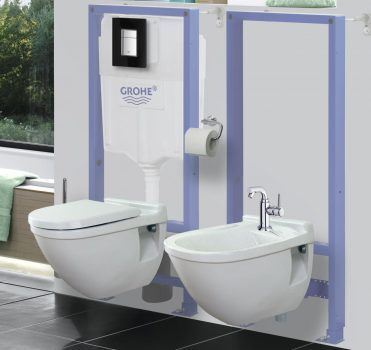
There are also disadvantages, and for some they are decisive when refusing to install a suspended model. For example, not all bathrooms have enough space to install a masking panel.
The second drawback is related to the complexity of repair work - sometimes it is necessary to dismantle the protective screen. But the main disadvantage is the prohibitive price of kits with installations for some categories of citizens, so they have to make do with economical floor models.
Typical installation diagrams
If we consider the installation of various bidet modifications, we can distinguish the following working schemes:
- installation of a suspended structure on the installation;
- installation of the floor model (with bolts, glue or cement);
- fixing the bidet lid;
- installation of a model with a flexible shower hose.
However, we are specifically interested in the installation, and from this perspective we can consider only three installation options:
- separate frame;
- common frame with toilet;
- corner modification.
The choice depends on financial capabilities, availability of free space and equipment. The most popular is the scheme with the installation of a separate installation.
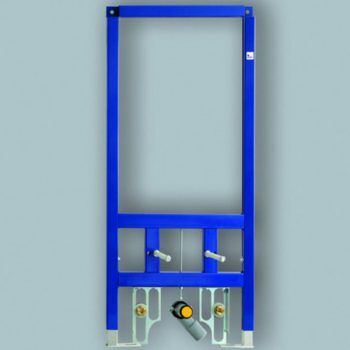
Cold water is supplied to the toilet tank, and cold and hot water lines must be connected to the bidet, since the bowl design is equipped with specialized mixer, the installation and connection of which will be explained in our recommended article.
A convenient handle is usually attached to the shelf of the bowl adjacent to the wall, with which you can adjust the water temperature. For expensive devices, temperature parameters are set automatically.
Do-it-yourself installation installation
Metal installation for hanging bidet installations purchased together with the device. Top manufacturers produce universal designs that are suitable for hanging bowls of different sizes and weights. Each frame comes with detailed instructions - a step-by-step guide with a set of diagrams and drawings.
Let's consider each stage of installation separately - this will be useful if you decide to equip the bathroom yourself.
Selecting a location – optimizing space
It is better to start work by drawing up a project. It may look different, but most often it is an interior sketch or a drawing of a room indicating all plumbing fixtures. In addition to the bidet and wall hung toilet it is necessary to mark important communications - the sewer line and pipes for supplying cold and hot water.
Do not rely on approximate dimensions. In tight spaces, every centimeter of space matters. You must first find out the exact dimensions of installations and plumbing fixtures, and only then draw diagrams.
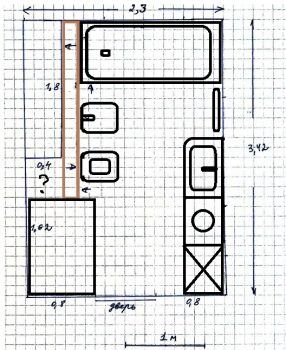
The placement of the bathtub, toilet, bidet and sink should be thought out as much as possible.Plumbing fixtures must be positioned so that there are no difficulties with their use in the future.
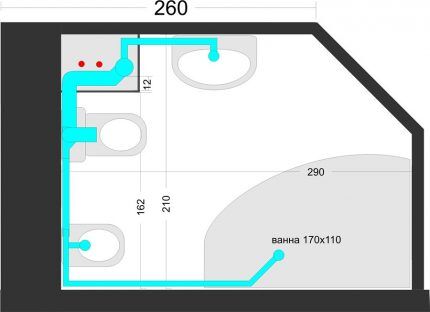
Pay special attention to the installation support. It should be a strong supporting structure made of brick or concrete (less often wood), suitable in size. Please note that most installations are attached to the wall and floor. If there is a shortage of free space, consider the option of a corner modification.
In case of extremely limited space in the bathroom, you should pay attention to corner installations. It is possible that one of the devices from a pair of toilet-bidet or wall-hung sink can be placed near the protruding part of the wall. It all depends on the specific layout.
Preparation of tools and materials
In addition to the pre-selected bidet model and the installation that matches it, you must purchase a kit for installing and decorating the suspended structure. You should definitely think about what material is best to use for constructing a box or false wall.
Plastic panels are considered the easiest to install. If you decide to cover your hanging bidet installation with wooden slats or plasterboard, be sure to protect the material from exposure to a damp environment.
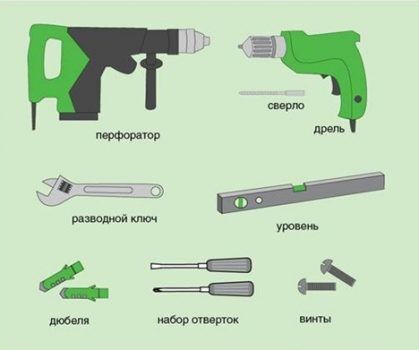
No matter how much you rely on your own strength and the advice of experienced craftsmen, the main guide is always the manufacturer’s instructions - you need to keep it at hand at all times. Check the bidet package; you may need a cuff to connect to the sewer.
Mounting the installation on the wall
When preparation is complete, you can begin wall mounting of the frame. Using a tape measure and a marker, mark the attachment points directly vertically relative to the floor.
We draw all horizontal lines using a level. To check the correctness of the marks, from time to time we place a metal frame against the wall - the holes in the wall and on the floor must coincide with the places of fastenings on the frame.
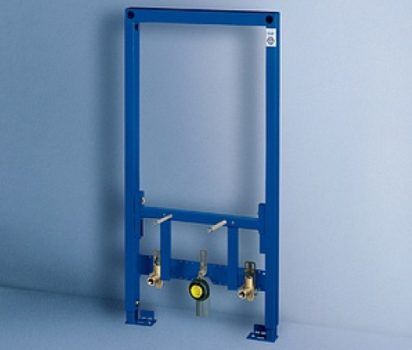
Having marked the places for fastenings (usually 2 on the wall and 2 on the floor), we make holes, then using the dowels and bolts included in the package, we screw the frame to the wall. Use a key to tighten the height-regulating clamps (located on both sides of the frame).
We take a level and check the position again - the frame must be installed strictly vertically, the reliability of the structure depends on this. If necessary, make adjustments using the mounting bolts.
Important points when installing the installation:
We screw the studs (long holders for the bidet bowl) last.
Connecting water supply and sewerage
Pipes and outlets for connection must be installed before installing the decorative screen or box. There are two options: in the first case, the mains are already connected, in the second, the installation is first secured.
The second solution is suitable for new housing, where the internal wiring has not been done in advance. It is also more convenient, since the water supply and sewer pipes can be connected, already focusing on the location of the installation outlets.
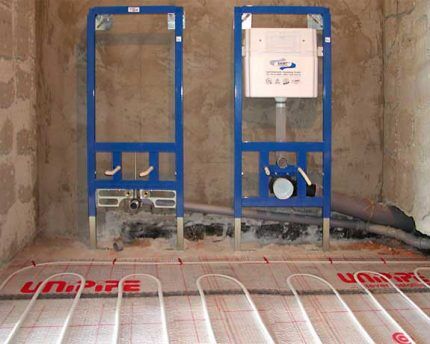
To connect indoor pipes to the bidet, we install adapters, which we mount on a special frame plate. We attach them in such a way that after installing the false wall they protrude above its surface by at least 20 mm. In the future, we will insert an outlet from the bidet into the sewer socket, and connect it to the mixer into the water pipes.
Installation decoration options
There are many design solutions for masking installations for toilets and bidets, but there are only two main ones. They are hidden either behind a panel that completely covers the wall, or in a box, which as a result takes up less space, since it leaves part of the space free.
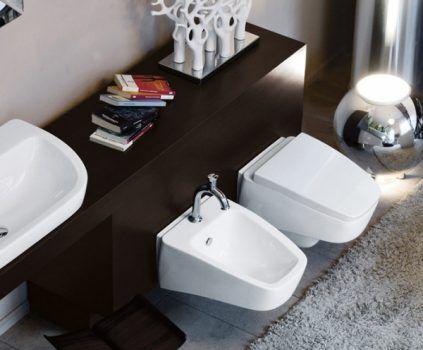
A solid wall, behind which all communications and supporting structures are hidden, makes the interior more noble and free from details. It can be painted, covered with waterproof wallpaper or ceramic tiles.
However, it must be remembered that various emergency situations (for example, leaks) are possible when a blank wall becomes an insurmountable obstacle to repair work.
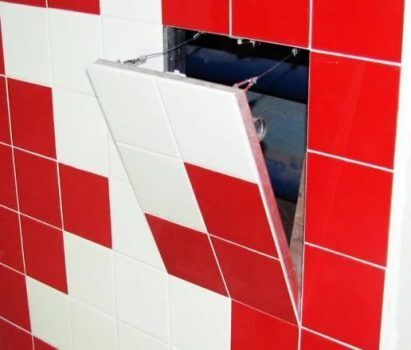
Simultaneously with the construction of the false walls, other finishing work is also completed, for example, tiling the walls and floor.
Installing a hanging bidet bowl
Attaching the bowl is the final stage of installing a hanging bidet on the installation. At this moment, we already have a completely closed wall, from which two pipes for water come out, one wider for connecting water seal, two mounting studs.
First, we take a plastic water seal, cut off a straight part to fit the size of the bowl and mount it to the outlet of the installation. Then we remove the protective covers from the studs and carefully “string” the bidet with a pre-installed mixer onto them.
We connect the water seal pipe, flexible hoses with water, and check the horizontal level. At the very end, tighten the nuts and put decorative caps on them.
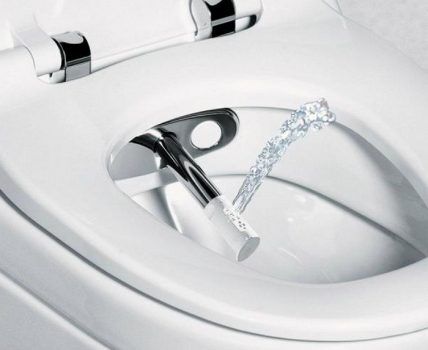
After testing the operation of the bidet, we consider the installation complete.
If there are serious difficulties in choosing a location for the bidet, you can get by with a mini-version of a useful hygienic device. Installing a bidet attachment on a regular toilet will be an excellent solution to the problem.
Conclusions and useful video on the topic
Qualified specialists and clear video instructions will tell you what to pay attention to when installing a bidet installation.
Video #1. Instructions for users of Roca products:
Video #2. A few tips for installation and adjustment:
Video #3. Bidet installation overview:
A beautiful and comfortable bathroom interior is the dream of modern home owners. Installation for a hanging bidet can provide residents with the necessary comfort and aesthetic appeal.
Using the instructions and drawings, you can install the structure yourself, but all the installation details are known only to plumbers.
Tell us about how you installed the installation in your bathroom. It is possible that you have valuable information about the intricacies of the process that are not noted in the article. Please share useful information, ask questions, and post photos related to the topic of the material in the block below.




I don’t have much space in my bathroom, so when they wanted to install a bidet, installation was the only option. The toilet also had to be replaced with a wall-hung model. Due to this, we managed to gain a little and, with sin, place them in half.
If it weren’t for forced necessity, I would have done without installations; the installation was very complicated, and the plumbers had to pay a hefty sum.
And if the water sockets in the installation are recessed by 38 mm.in relation to the frame, do they need to be built up with extensions to the final wall level?
Hello, Alexey. In fact, it is not very common for water sockets to be recessed into the installation frame. Often this decision is caused by design features. I’ll attach a few photos of different bidet installations that I had to deal with.
As you can see, all water sockets are laid out so that you can connect taps to them for cold and hot water supply lines and bring them outside the false wall of sufficient thickness. A bidet can be freely connected to the fittings installed on the pipes.
If in your case, due to the fact that the water sockets are recessed, it is not possible to install the bidet due to the insufficient length of the fitting pipes, then it means that errors were made during assembly.
Today I found out that when installing the bidet, one of the pins was not screwed into the frame. And since the tiles were already laid and grouted, the builder started using chemicals. He assures me that everything will be fine and you can even dance on the bidet))) but I doubt it. Or in vain?